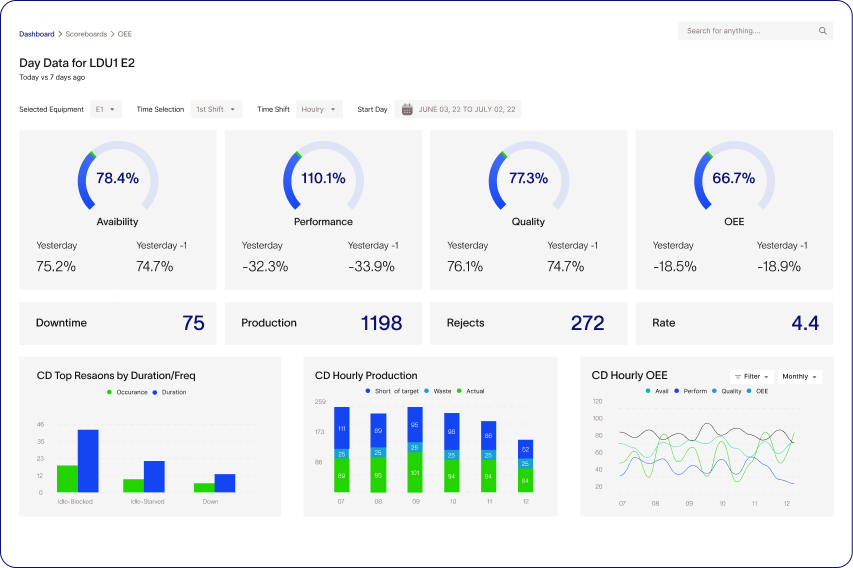Manufacturing Analytics: A Data-Driven Leap for 10-15% in Quality Boost and Waste Reduction
Examine how Algood addressed its challenges in quality control, scheduling, and waste reduction by adopting data analytics. By collecting detailed data on their processes and employing predictive models, Algood significantly improved product quality, reduced waste, and optimized their production schedules, leading to considerable utility savings.
Increasing quality and reducing waste
10-15%
in first pass quality gains
With the benefits of gaining access to more data for decision-making, Our customer was able to realize impactful changes to their business performance. First-pass quality gains were up 10-15% , product downgrading changed by 10%, and they reduced waste by 5%. Schedule upsets were significantly reduced and they realized utility savings of 10%-15%.
The Challenge
This serves as a compelling illustration of the benefits that arise from incorporating advanced data collection and analysis technologies into manufacturing workflows, significantly boosting product quality and operational efficiency. The challenges encountered included:
- Variable Peanut Quality Affecting Roasting: The primary issue was securing peanuts of adequate quality for production orders. Lack of quality peanuts led to expedited production, often resulting in waste due to the peanuts being unsuitable for the intended products.
- Scheduling and Material Usage Inefficiencies: Using various inventory locations for peanut storage and scheduling their use based on availability proved inefficient. This approach frequently resulted in the unavailability of appropriately quality products when needed, leading to inefficiencies and waste.
- Production Delays from Slow Quality Checks: The extended duration required for quality checks allowed for the production of incorrect products over multiple shifts before detection of any issues. Such delays in error identification and rectification contributed to inefficiency and waste.
- Challenges with Environmental Variables: External conditions such as humidity, temperature fluctuations, and inherent variability in the peanuts (e.g., moisture content) could impact the roasting process. These uncontrollable factors made achieving consistent product quality challenging, as only process variables like burner levels, belt speeds, and airflow could be adjusted.
The solution was to harness more extensive data through the deployment of state-of-the-art technologies, including PLCs, HMIs, time series historians, various sensors, and an integrated production database with an ERP system. This strategic integration led to improved operational visibility, enhanced real-time monitoring and control, and better scheduling, material management, and quality control. However, it was also acknowledged that despite these technological advances, challenges from external environmental factors remained, highlighting the necessity for ongoing enhancements..
VP Operations
For Manufacturing Analytics, it is critical to have years of raw data before you know what issue you are trying to solve or optimize. INS3 experts recommended a solution and implemented the data collection on time and within budget.
The Solution
The strategy employed to address production issues showcases the power of data science within the manufacturing sector. The entity in question was confronted with the challenge of ensuring the high quality of their products, such as roasted peanuts. To overcome this obstacle, they utilized and expanded the data they already had been collecting. This effort involved gathering comprehensive data on various aspects of the peanut roasting process, including batch quality, types of peanuts used, and other variables affecting roasting efficacy.
To analyze this wealth of information, a data scientist was brought on board. This expert employed advanced modeling techniques to develop predictive models capable of learning and improving over time. These models were instrumental in forecasting the final color of the roasted peanuts, a crucial indicator of their quality. Subsequently, the company trained its staff to apply these predictive insights to fine-tune the roasting operations. By leveraging model-based recommendations, the workforce could achieve optimal roasting outcomes.
A key component of this successful strategy was the organization of the collected data into a Unified Name Space (UNS). Process data and sensor outputs were systematically arranged in a time-series format, facilitating effective monitoring and analysis across periods. Additionally, quality and production data were archived in an event database, enabling the association of specific production activities with their quality impacts. The fusion of the data scientist’s analytical prowess with the operational knowledge of the staff, underpinned by structured data management, was pivotal in resolving the identified challenges. This approach not only enhanced product quality but also streamlined the roasting process, exemplifying the transformative potential of data-driven strategies in enhancing business operations.
Highlights of the Solution:
- Comprehensive Data Collection
- Predictive Modeling
- Training and Automation
- Structured Data Management
- Improved Product Quality and Efficiency

The Results
The implementation of a data-driven approach led to significant improvements in their business performance:
- 10-15% increase in first-pass quality, indicating fewer products needed reworking.
- 10% reduction in the rate of product downgrading, showing that more products met quality standards.
- 5% waste reduction, highlighting more efficient production processes.
- Stabilized Schedules, leading to smoother operations.
- 10-15% increase in Utility Savings, reflecting more energy-efficient manufacturing.
These outcomes demonstrate the significant benefits of leveraging detailed data to inform and optimize manufacturing processes.
INS3 Tip
Not sure where to start? Start by collecting the time and event series data. Analytics run best with a lot of correlated data and you never know the variable that will be the most important. Or if you’ve got questions, let us help.
Plant Manager
Most good manufacturing solutions, start with a gut feel. They are proven (or not) with data, and then optimized with analytics.
Start your Digital Journey Right Now
No matter where you are in your Digital Transformation journey, we can help you establish next steps with our proven Pathfinder Process, where we analyze people, processes and technology to determine your plant rediness for digital transformation, resulting in a plan with a budget.


